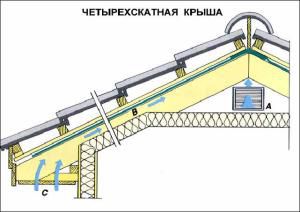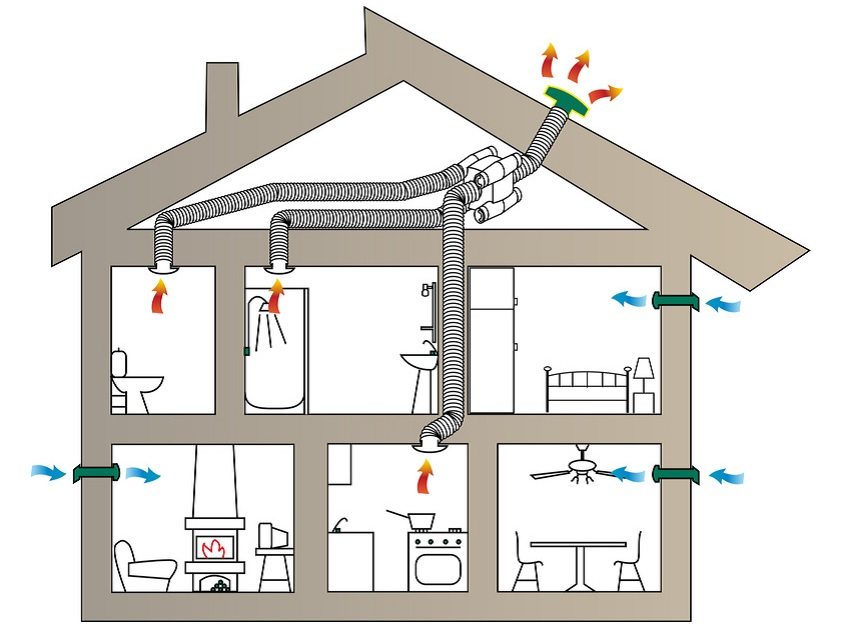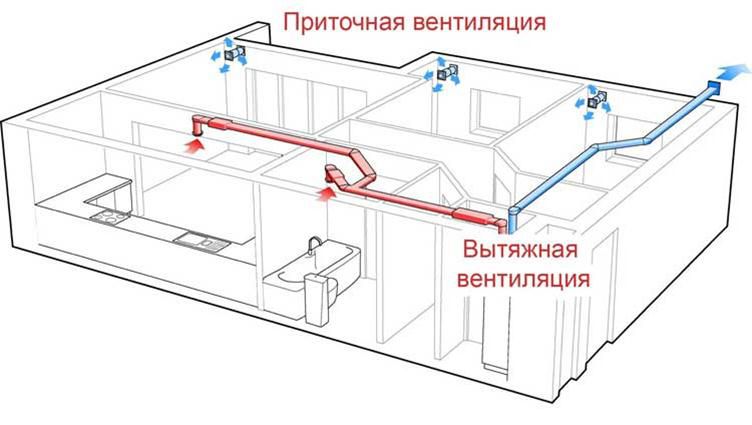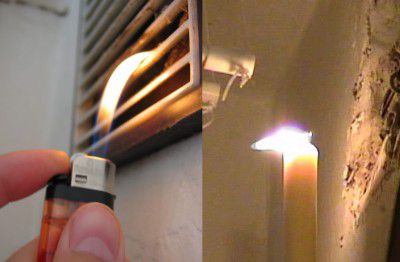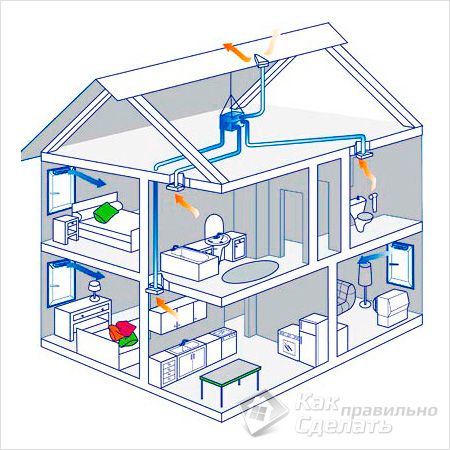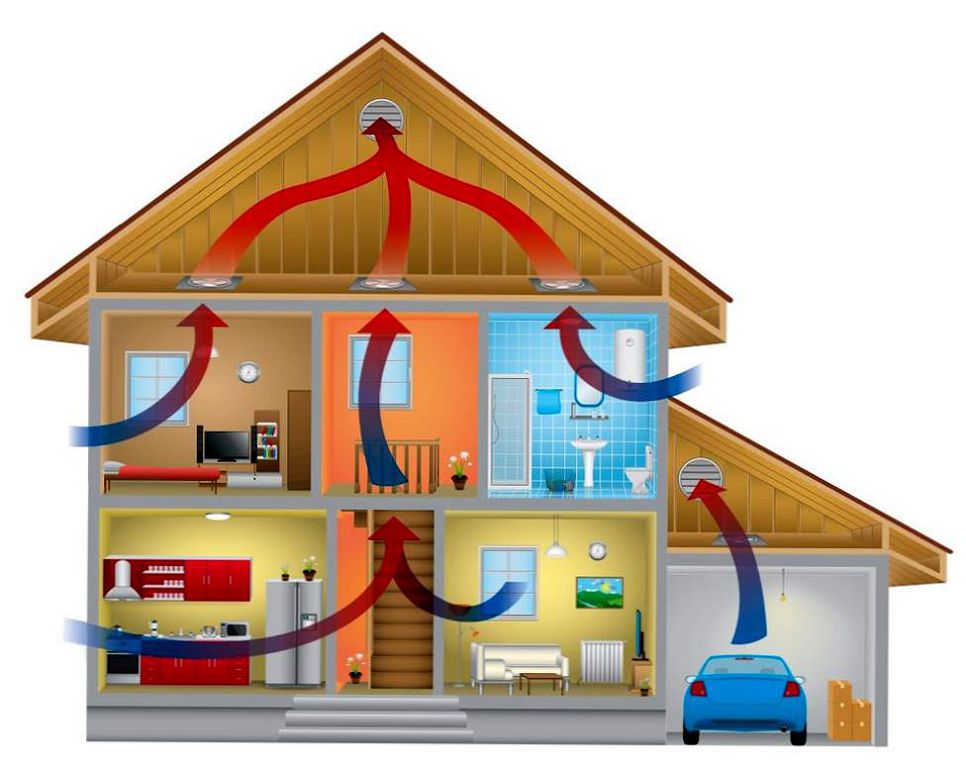Ventilation of the roof of the house is necessary, as well as ventilation of the attic or bathroom. On the surface of an unventilated roof, the temperature and humidity regime is violated. Condensation droplets settle on the roofing material and supporting structures, causing rotting, decay and frequent repairs.
- Why roof ventilation is necessary
- Roof ventilation methods
- Shingle roof ventilation
- Forced ventilation of flexible roof
- Mansard roof ventilation
- Steam and waterproofing of the roof
- Ridge ventilation aerator
- Mansard roof deflectors
- Metal roof ventilation
- Installation of a point outlet for ventilation
- Roof ventilation from corrugated board
- Shed roof ventilation
- Hip roof ventilation
Why roof ventilation is necessary

Due to the temperature difference, condensation collects in the under-roof space. Water penetrates into the insulation, its insulating qualities deteriorate. The more moisture under the roof, the worse it keeps the temperature.
Most often, the rafter system is assembled from wood, which is prone to rotting with constant contact with moisture. Moldy rafters collapse, threatening to collapse.
The accumulation of water in a soft-material roof carpet causes the coating to flake off. The roof starts to leak. And only roof ventilation will help prevent all troubles.
Advantages of houses with ventilated roofs:
- the under-roof space is blown with fresh outside air;
- the optimum temperature and humidity in the attic is maintained;
- the properties of the heat-insulating material are preserved;
- materials of the roof and supporting structures are protected from mold, mildew, sagging.
Poor roof ventilation in a private house causes:
- wetting of the rafter structure, rotting, deterioration of the bearing properties;
- deformation or rusting of the roofing material;
- destruction of stone and concrete parts;
- a decrease in the thermal insulation qualities of the roof, which means an increase in the cost of heating the house;
- overheating of the house and roof during the hot season.
In this regard, mention should be made of the importance of ventilation in the mansard roof, where the under-roof space is residential.
Roof ventilation methods
Ventilation of the roof of any private house is carried out by the method of natural air movement in the under-roof space.
There are several mechanisms for providing roof ventilation in a private house:
- ventilation of the ridge of a gable roof.
- eaves ventilation.
- exhaust roof fans.
- piece elements with ventilation holes.
- skates of a special design.
- ventilation gaps, which are provided during the installation of the roof.
- dormer windows in the attic.
And now we will consider the features of different ventilation designs for roofs of houses, assembled from different materials.
Shingle roof ventilation
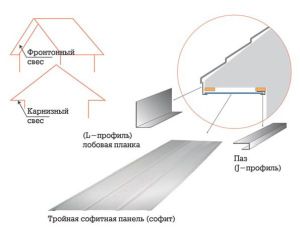
When laying shingles, a ventilation gap must be left. But for the free movement of air on both sides of the roof, several more conditions must be met.
Shingle roof ventilation requirements:
- A 50 mm bar is inserted between the insulation and the base of the roof;
- At the bottom of the roof slope, ventilation slots are left through which fresh air enters. It is a popular settlement for small birds. Therefore, it is advisable to cover the slots for ventilation of the roof from the soft roof with lattice or soffits;
- Air exhaust is provided by ridge vents or aerators;
- The lathing is installed in a special way, with breaks, so that air flows freely pass from bottom to top;
- The height of the air gap is determined by the thickness of the timber. Which is chosen depending on the length of the slope and the angle of inclination of the roof. Only a specialist can correctly calculate the width of the air gap.
For example, when the length of the slope is 5 meters, the angle is 10 degrees - 5 cm is enough, if the angle is the same, and the length of the slope is 25 meters, you need a beam 10 cm thick.
Ventilation of a roof from a soft roof can be made 1 or 2-contour. The two-circuit system is illustrated in the accompanying illustration.
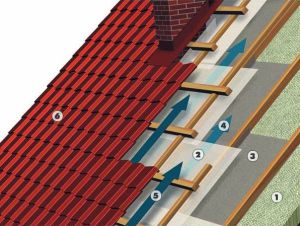
Here:
1 - insulation,2 - vapor barrier,3 - hurricane protection,4 - the first slot for ventilation,5 - the second slot for ventilation,6 - roof covering.
Forced ventilation of flexible roof
Aerators are installed to increase the ventilation efficiency of the roofing from flexible tiles. There is always a reduced pressure in the aerator, so the draft never disappears.
Aerators are available in various diameters and heights. The size and quantity are selected depending on the roof area of the shingles.
Ventilation with aerators is equipped according to the rules:
- there must be at least 12 meters between two aerators;
- they are installed on the highest places of the roof, evenly;
- if the roof has recently been installed, it is preferable to choose the joints of the insulation;
- if aerators are installed during the repair of a roof from a soft roof, the best place for the ventilation element is where the roof is slightly swollen;
- the diameter of the hole for the vane should be 1 - 2 cm larger than the diameter of the pipe itself;
- the aerator is attached with anchor bolts or dowels;
- the joint must be treated with a sealant or a special tape must be glued on.
Mansard roof ventilation
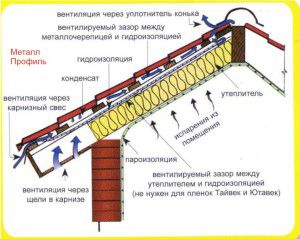
Ventilation of the roof over the attic has an additional essential function of regulating the temperature inside the residential attic. The bottom surface of the roofing cake is actually adjacent to its ceiling. Thus, the movement of air along the inner plane provides additional thermal insulation. Therefore, a special technology has been created for constructing ventilation of mansard roofs with the output of humid, hot or cold air to the outside.
The principles of natural ventilation are used: warm air is forced out by a cold stream coming from below.
Components of roof ventilation attic:
- vapor barrier film or membrane (selected with minimum permeability);
- insulation that is placed between the rafters;
- lathing;
- counter-lattice made of slats or bar;
- waterproofing;
- roof covering.
The diffusion membrane completely prevents the accumulation of condensate. A special membrane fabric prevents moisture from below (from the living space of the attic) to the lower surface of the roof. At the same time, a gap remains under the roofing material for the unhindered movement of air masses. Waterproofing prevents the penetration of moisture from the outside.
It is also necessary to provide slots in the eaves for air inlet and in the area of the ridge for exits. The upper ventilation gap is located between the waterproofing and the roofing. Water entering from the street evaporates through this vent. The structures supporting the roof are also well ventilated.
The lower ventilation slot is located between the waterproofing and the insulating layer. Through it, water evaporates, penetrating into the insulation from below. The air from the living quarters is saturated with water vapor, which must be removed.
Steam and waterproofing of the roof
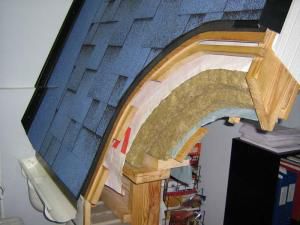
Insulating films are laid on the rafters, between which they leave gaps of no more than 120 cm. To prevent condensation from getting on wooden beams, the film is mounted with a sagging of 1 - 2 cm. Fasten it with a stapler or nails with a wide galvanized head. If the cap is not large enough, the film will break.The canvases are laid out with an overlap of 15 cm, which is glued with tape.
There should be a gap of at least 4 cm between the insulating layer and the waterproofing. The film is rolled out along the rafters and fastened with slats along them, nailing with galvanized nails.
The counter lattice consists of bars that are installed at intervals of 15 cm.
In the area of the ridge, leave 5 cm between the edge of the insulation and the axis of the ridge for ventilation. And only now it is possible to construct a crate, the type of which depends on the material of the roof.
It is important to properly handle the places where the pipes enter the roofing cake. The film is cut in the form of a truncated triangle. It turns out a kind of valves that are attached to the walls of the pipe or bars with a sealant tape.
The vapor barrier is mounted vnatyag, the bottom gap is not left. But the upper air between the membrane and the crate is necessary.
To protect the roofing material from exposure to steam from living quarters, fleecy membranes are used, attached to the insulation with a smooth surface inside. On small hairs, water droplets are held, not rolling into puddles. Such a vapor barrier extends the life of the insulation and wooden structures, preserves the quality of the insulation. Thanks to the film, mold colonies are not formed on the rafters.
The vapor barrier canvases are rolled across the insulation material, with an overlap of 15 cm, the edges are glued with special tape.
Ridge ventilation aerator
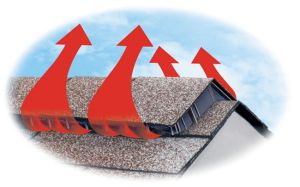
The ridge aerator provides ventilation to the roof ridge and helps maintain temperature and humidity in the attic. Ready-made ridge aerators can be mounted on any type of roof.
They are installed only on roofs with a slope of 14 to 45 degrees. Ridge vents must be installed on the roof. The length of the aerator must match the length of the ridge. A distance of 30 cm or more is maintained from the chimney to the ridge cut. The structure of the ventilated roof ridge must be airtight.
Mansard roof deflectors
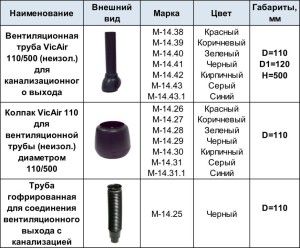
Deflectors or roof aerators are mechanisms for removing moisture and steam from a roofing cake. The aerator uses the convection method.
The deflector in the attic roof provides:
- evacuation of steam before it reaches the roofing materials;
- reduction of pressure, preventing the appearance of swelling of mineral wool used as insulation;
- evacuation of moisture from mineral wool, preventing condensation.
According to the standards for ventilation of attic-type roofs, it is necessary to equip 1 deflector for every 100 sq. meters. This density allows you to effectively remove excess moisture. If the valley of the roof is very steep and the ridge is inclined, the deflectors are placed in the valley and along the ridge run at the joints of the insulation layer.
Metal roof ventilation
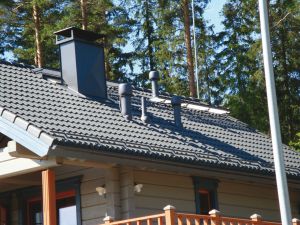
Ventilation of the roof of a house made of metal tiles has some features.
Continuous ventilation is provided during the installation of the roofing pie and consists in the fact that a gap of up to 5 cm is left between the roofing material and the thermal insulation. The lower layer of insulation is ventilated thanks to a slot 5 cm thick to the lathing. And so that the wood does not get wet, a seal is placed under the ridge.
The area of the ventilation slots at the eaves should be equal to the area of the ridge vents (the volume of the inflow is equal to the volume of the outflow). The total area of the vents should be 1% of the roof area. If, during the design and construction of a house, ventilation of a roof made of metal tiles is not thought out, there is an express method for ready-made roofs.
In this case, ventilation pipes and ventilation outlets form the basis of roof ventilation. The pipe height must be 50 cm or more. For every 60 sq. meters of roof area, 1 pipe is installed as close as possible to the ridge.By the time of installation of the point ventilation outlets, the video of which we present, the metal roof must be completely assembled.
Most often, plastic pipes are used, they do not violate the appearance of the building and serve for a long time.
In areas with heavy snowfalls in winter, pipes up to 65 cm long are installed. The joints of pipes to the roof are hermetically sealed. When the roof is flat, and the slopes are more than 6 m long, ventilation joints are equipped. Height of abutments from 40 cm above the roof. Instead of a regular pipe, it is sometimes more effective to use the deflectors shown in the video of ventilation of a roof made of metal.
Ventilation of the roof ridge under the metal tile is provided by a ridge board separating the two roof slopes. On one side, air escapes unhindered, preventing condensation from forming.
Natural draft is used to ventilate the space under the roof. And it will work only if the number and location of the ventilation outlets are accurately calculated.
Installation of a point outlet for ventilation
Point outlets are suitable for ventilation of small hip and pitched roofs. Composite roofs with several ridge are equipped with an exit at each ridge. The distance to the ridge should not be more than 0.6 m. It is not advisable to mount two outputs on one sheet of metal, so as not to weaken the structure.
When purchasing a ventilation outlet for a roof made of metal tiles, the following parameters are taken into account:
- the profile of the lining must match the profile of the metal tile;
- pipe color;
- temperature limits for this instance;
- the kit should include installation instructions, overlays, template, fasteners, the pipe itself, as well as the passage element;
- the diameter of the pipe depends on the roof area.
The most important point in installing point ventilation for a roof made of metal tiles is cutting a hole of the required size and sealed installation of the pipe. If the device is assembled correctly, in accordance with the annotation, then the junction to the roof will be insulated from rain or snow.
The hole is cut clearly according to the attached template using metal scissors or a hacksaw, but not a grinder, which spoils the coating.
The tightness is ensured by silicone, which is used to process the sealing ring. Next, the passage element is attached with screws from the kit and the pipe is inserted into it. The pass-through is required to fix the pipe. To make the fastening reliable, the hole in it is cut one quarter less than the diameter of the pipe. Sometimes this unit is sold already assembled. The pipe must be installed vertically, which is checked with a level. Now it is fastened with screws and covered with decorative overlays.
Roof ventilation from corrugated board

Ventilation of a roof made of corrugated board is organized by a natural method, similar to the ventilation of a roof made of metal tiles shown in the video. In the area of the eaves overhang, air penetrates into the sub-floor space, freely passes up to the ridge and is discharged with a hipped ridge. If the ridge is no longer than 10 m, through the end.
Ventilation of the under-deck space of the roof made of corrugated board is provided by installing ventilation slats on the waterproofing layer. The lowest rail near the eaves should be 50% thicker than the others.
The waterproofing does not reach the ridge of the roof, so that, while providing high-quality ventilation of the roof from the corrugated board, it does not interfere with the escape of vapors. And water leakage from the outside is prevented by sealing the ridge with a “top-roll” system. You can also install a roof ridge ventilation under the corrugated board or metal roofing.
Shed roof ventilation
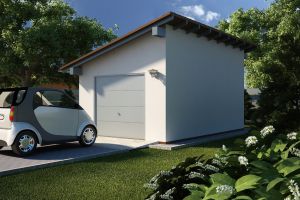
Most often, pitched roofs are installed over verandas and terraces, where ventilation is not needed. And a completely different situation when it is above a residential building. Ventilation of a pitched roof is very simple to equip and this is a great design advantage.There is no need to purchase aerators or mount a special shaped ridge, but only to correctly assemble the roof itself.
A pitched roof certainly needs ventilation. A place is left under the roofing material for the free movement of air flows. The movement is carried out from bottom to top. Therefore, a gap is left between the thermal insulation layer and the waterproofing. Additional ventilation holes are often drilled in the elbow walls.
Roof overhangs are sewn up with perforated soffits. When installing the battens, small gaps are left between the boards. Ventilation grilles can also be installed. Shed roofs are ventilated with an angle of inclination of 5 - 20 degrees.
Hip roof ventilation
Therefore, special attention should be paid to the wind filing of the cornices. If the cornice is hemmed with wood, gaps are left between the boards. It is more convenient to make a filing from ready-made perforated plastic (spotlights). If the filing is already ready, and ventilation is not provided, openings are cut into which the grilles for ventilation of the hip roof are mounted. The diameter of the grates is 5 cm, they are covered with a fine mesh. Gaps of no more than 0.8 meters are left between the gratings. There are models on sale in a variety of colors and shapes.

